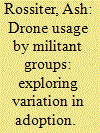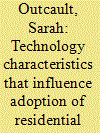|
|
|
Sort Order |
|
|
|
Items / Page
|
|
|
|
|
|
|
| Srl | Item |
| 1 |
ID:
160998


|
|
|
|
|
| Summary/Abstract |
Judging by recent media reporting and pronouncements by senior US military and security officials, the use of drones by militant groups is both reshaping conflict between armed non-state actors and state parties and now presents a grave and direct threat to nations in the West and elsewhere. But does this threat warrant the attention it is currently receiving? To answer this question, this article surveys how various militant groups have used drones both tactically on the battlefield and for wider strategic purposes. Closely examining how drones have been employed and by whom provides a basis for understanding variation in adoption. The article shows how drone usage or non-usage is highly contingent on the setting of the conflict, the aims of different groups, and the capacity of groups to adopt the technology. Though advances in drone technology could make the use-case more appealing for militant groups, drones will be subject to the same back-and-forth, techno-tactical adaptation dynamic between adversaries that have accompanied prior military innovations.
|
|
|
|
|
|
|
|
|
|
|
|
|
|
|
|
| 2 |
ID:
127224


|
|
|
|
|
| Publication |
2014.
|
| Summary/Abstract |
The maximum amount of land for growing switchgrass for ethanol is estimated for a region in the southeastern U.S. Breakeven capacities are calculated for land in row crops, hay, pasture and marginal land. Characteristics of land categories inform potential land use change impacts as well as switchgrass profitability. Variable yields within and across land categories are translated into distributions of switchgrass net revenue. Breakeven curves are generated for a range of switchgrass prices. These curves provide upper bounds for further analysis of actual switchgrass adoption in context of broader economic forces and possible policy mechanisms to minimize environmental impacts. A farm-gate price of $55 Mg?1 is estimated for half of marginal and pasturelands to break even with switchgrass. At this price, only 20% of land in hay and a small fraction of row crop hectares break even. Half of hay and row crops hectares break even at approximately $90 Mg?1 and $100 Mg?1, respectively. At $60 Mg?1, sufficient land area can profitably produce switchgrass for ethanol to displace approximately 10% of gasoline consumed in Georgia, North Carolina, and South Carolina; however, this price only indicates breakeven capacity implying that higher prices may be necessary to realize 10% displacement.
|
|
|
|
|
|
|
|
|
|
|
|
|
|
|
|
| 3 |
ID:
183567


|
|
|
|
|
| Summary/Abstract |
Prior research on adoption of rooftop solar has investigated various economic and psychological factors contributing to or impeding adoption. One psychological factor that has been linked to environmental behavior in other settings, but not yet in the context of rooftop solar, is place attachment, an individual's sense of attachment to their community. Using a survey of over 3700 homeowners in Los Angeles County, we examine the impact of place attachment, relative to that of pro-environmental attitudes, on the decision whether to consider rooftop solar and on the decision whether to adopt it. We find that an otherwise average homeowner with pro-environmental attitudes one unit above the mean is 5.66 percentage points more likely to consider rooftop solar, while the effect of place attachment on consideration is not significant. However, among respondents who consider rooftop solar, an otherwise average homeowner with one unit stronger place attachment is 7.59 percentage points more likely to adopt, while the effect of pro-environmental attitudes on adoption is not significant. Policymakers seeking to encourage adoption of rooftop solar should contemplate leveraging place attachment, and should recognize that different policy mechanisms will be effective for homeowners in general than for those who are already considering.
|
|
|
|
|
|
|
|
|
|
|
|
|
|
|
|
| 4 |
ID:
178845


|
|
|
|
|
| Summary/Abstract |
This article examines policy approaches impacting the adoption of alternative energy technology. Researchers investigated the factors affecting the transition to automated wood pellet heating (AWPH) in northeastern US as an example of the early stages of an energy transition in small-scale heating. The research team applied diffusion of innovation theory and the multi-level perspective on sociotechnical transitions to develop a system-wide analysis of the AWPH transition, incorporating multiple actor groups and policy strategies. Sixty interviews were conducted across four northeastern states with adopters and informed non-adopters of AWPH, and with industry, policy, and community representatives. Using interview results and theory, surveys were developed and distributed state-wide to both adopters and non-adopters with 690 useable responses (38% response rate). Qualitative and quantitative data analysis found differences in the factors impacting AWPH adoption between those within the Model Neighborhood Project (MNP), a privately-run program aimed at accelerating the diffusion of AWPH, and those who had access to state-run programs alone. These differences and the success of the MNP suggest that policy aimed at supporting early-stage energy transitions should incorporate not only consumer financial incentives, but also build a local network of supply-side actors through community-based outreach and technical support.
|
|
|
|
|
|
|
|
|
|
|
|
|
|
|
|
| 5 |
ID:
186499


|
|
|
|
|
| Summary/Abstract |
Distributed energy resources (DERs) present an important opportunity to lower the carbon intensity of residential buildings but face numerous barriers to adoption. This paper extends and adapts Rogers' theory of the role of technology characteristics in the diffusion of innovation (Rogers, 1962) to address the unique features of residential DERs. A structured review of the academic and industry literature was conducted to gather data on the technology characteristics that influence residential DER adoption. Careful coding, analysis, and operationalization of the technology characteristics yielded 14 that are relevant, applicable, specific, independent, and distinct from each other. The 14 technology characteristics and logic behind their identification comprise a classification scheme to guide the exploration of how the technology characteristics of residential DERs influence their adoption. Building on that framework, an assessment tool was developed to evaluate technology adoptability, facilitate comparisons across technologies, and identify the specific technology characteristics that pose a challenge for each DER. The framework and the assessment tool can be used by researchers, practitioners, and policymakers to better understand and address the technology characteristics that hinder adoption of residential DERs.
|
|
|
|
|
|
|
|
|
|
|
|
|
|
|
|
|
|
|
|
|